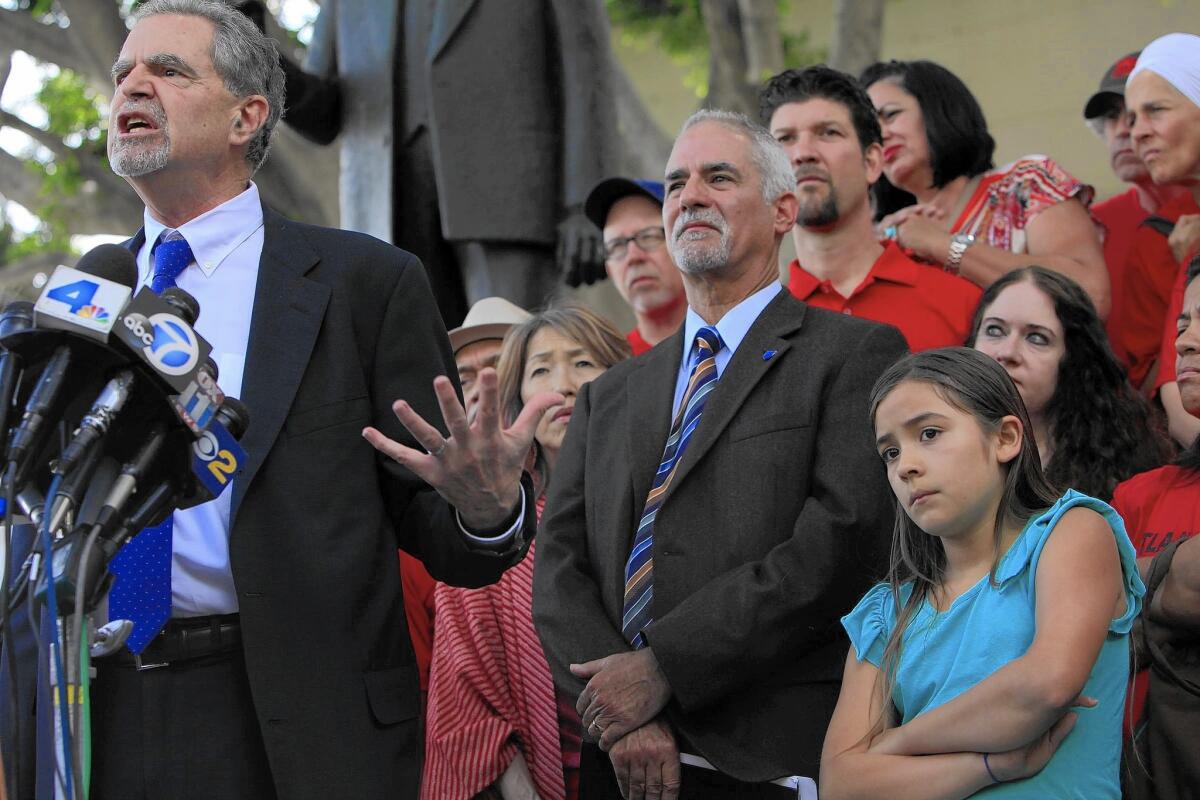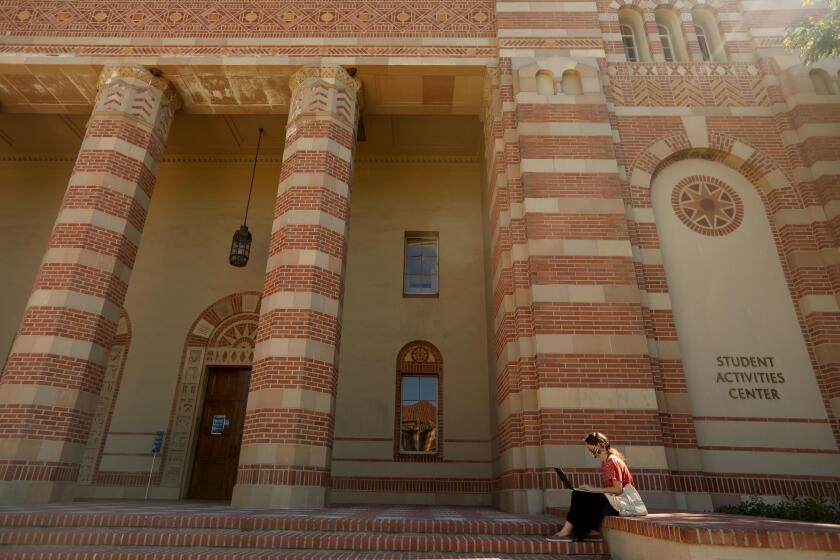How easy should it be to fire bad teachers? A landmark case may decide for California

- Share via
The sides squaring off in a Los Angeles appeals courtroom on Thursday in the landmark case of Vergara vs. California agree on this: Teachers are key to whether students founder or thrive, and far too many students are failing or falling behind.
The debate over how to address that problem has erupted into a pivotal fight over the competing and complementary rights of students and teachers.
The people who slammed the state with this high-stakes lawsuit have a straightforward prescription: Make it easier for schools to get rid of bad teachers.
Their opponents, including Gov. Jerry Brown and the state’s powerful teachers unions, characterize this solution as simplistic and even dangerous.
In 2014, L.A. Superior Court Judge Rolf M. Treu sided with the diverse group of nine students who brought the suit with support from a number of wealthy backers who want to see schools become more businesslike.
Treu threw out the state’s tenure and seniority systems, saying they harmed all students, but especially poor and minority students, leading to outcomes that “shocked the conscience.”
If that ruling holds up under appeal, teachers at unionized schools will no longer be entitled to a level of job security that’s rare, even in the public sector.
There’s been a tendency to say in the past that what’s good for teachers must be good for kids. This case, I think, exploded that argument.
— Eric A. Hanushek, a senior fellow at the conservative Hoover Institution of Stanford University
Other rules making it difficult and expensive to fire teachers would disappear as well. And when districts lay off teachers, those who’ve been around longest would no longer be guaranteed that they’ll be the last to get pink slips. Instead, districts could use a teacher’s performance to decide who to let go.
Timothy Daly, former president of a group called the New Teacher Project, applauds the lawsuit, saying that those challenging the state “are trying to prove that the laws make it impossible for districts to do the right thing for kids.”
This viewpoint holds that employment laws pushed through by unions — which are the state’s largest contributors to political campaigns — are depriving young people of the education to which the state Constitution entitles them. Poor children and students of color, this side argues, are disproportionately harmed because the worst teachers tend to wind up at poorly performing schools.
Opponents of the lawsuit, however, insist that the approach endorsed by the Superior Court judge would result in a lower-quality teaching corps. They say that the profession would attract and retain fewer of the sort of talented people who have other career options.
“Ensuring high-quality teaching starts with recruiting, supporting and retaining great teachers for all our students, particularly students who are most at risk and in need,” Michael Powell, a top official with the American Federation of Teachers, wrote in a memo released Wednesday.
From the beginning, this case has been about more than the specific rules in question.
Pro-Vergara partisans sued, at least in part, to break a political stranglehold that state teachers unions have held over much of education policy through their lobbying presence and campaign cash — their cause made easier by the public’s generally positive view of teachers.
The California Teachers Assn., which is pushing the appeal, is one of the state’s most powerful interest groups. Its allies include such elected officials as Gov. Brown and state Supt. of Public Instruction Tom Torlakson, who have signed their names to efforts to overturn the ruling.
The union opponents, on a panoply of education issues, are hardly powerless victims. They include L.A.-based philanthropist Eli Broad, former New York City Mayor Michael R. Bloomberg and the Walton Family Foundation, endowed by the Wal-Mart heirs.
The Vergara case itself is paid for through the group Students Matter, founded by Silicon Valley entrepreneur David Welch.
Some on the anti-union side have ties to business interests that would benefit from a changed legal landscape. Others have an anti-union agenda they are pursuing on multiple fronts.
Vergara backers say the case has broken through both legally and in the public consciousness.
“There’s been a tendency to say in the past that what’s good for teachers must be good for kids,” said Eric A. Hanushek, a senior fellow at the conservative Hoover Institution of Stanford University. “This case, I think, exploded that argument.
“You have to say: Why is this policy for people who work in schools consistent with a policy that emphasizes student achievement? You have to make that case,” said Hanushek, who testified for the plaintiffs.
But both sides face hurdles before the appeals court, said Michael Petrilli, president of the Washington-based Thomas B. Fordham Institute, a conservative education think tank.
“For the unions, I just think that it’s going to be hard to make the case that these policies aren’t having a disparate impact on minority children,” said Petrilli, who is regarded as an ally of pro-Vergara advocates.
See more of our top stories on Facebook >>
While unions are wary of weakening job protections on principle, many educators are not moved to defend the two-year tenure system at all costs. And providing teachers with a higher level of protection than other government and school district employees could continue to prove a hard sell in court, let alone the court of public opinion.
Teachers defend their special status as necessary to academic freedom, to being able to speak up on behalf of students without fear of retribution. They point out, too, that the ranks of teachers in California are declining.
The Vergara attorneys also face hurdles before the court, Petrilli said.
“Plaintiffs have to demonstrate that their preferred solutions are going to make a difference in reducing that inequity, and I think that’s going to be tricky,” he said.
At the original 2014 trial, the Vergara attorneys offered testimony from students describing their personal experiences with bad teachers.
They put experts on the stand who have researched the impact of effective versus ineffective teachers, claiming that students with grossly ineffective teachers lose out on two to four months of learning per year.
And they presented an economist who’d studied the impact of a good education — concluding that one year with a terrible teacher can decrease a classroom’s collective lifetime earnings by $250,000.
In its appeal, the union’s lawyers will argue that Judge Treu waded into a political and ideological debate and essentially landed on one side, relying on unproven assumptions and research findings that remain controversial.
“We think it will be overturned,” said Eric C. Heins, president of the California Teachers Assn. “Nobody wants a bad teacher in front of a student, least of all any other teacher, because we end up picking up the slack. This case is not about that.”
The three-judge panel hearing the appeals arguments on Thursday has 90 days to reach a decision. Both sides anticipate the case will then move to the California Supreme Court. If the ruling stands, the Legislature could try to approve other, more limited job protections for teachers.
Twitter: @howardblume
Twitter: @Joy_Resmovits
Editor’s note: Education Matters receives funding from a number of foundations, including one or more mentioned in this article. The California Community Foundation and United Way of Greater Los Angeles administer grants from the Baxter Family Foundation, the Broad Foundation, the California Endowment and the Wasserman Foundation. Under terms of the grants, The Times retains complete control over editorial content.
MORE EDUCATION NEWS
The problem with slut shaming in schools
Why L.A. Unified’s graduation rate is expected to soar this year
Thanks to Nike’s Phil Knight, Stanford is planning an ambitious graduate scholars program
More to Read
Sign up for Essential California
The most important California stories and recommendations in your inbox every morning.
You may occasionally receive promotional content from the Los Angeles Times.











